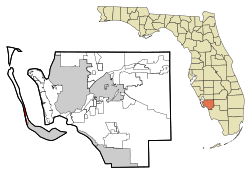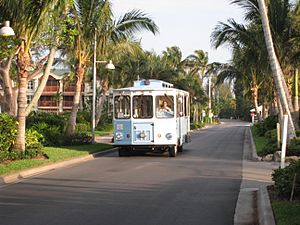Captiva, Florida facts for kids
Quick facts for kids
Captiva, Florida
|
|
|---|---|

Location in Lee County and the state of Florida
|
|
| Country | United States |
| State | |
| County | Lee |
| Area | |
| • Total | 1.64 sq mi (4.26 km2) |
| • Land | 1.18 sq mi (3.06 km2) |
| • Water | 0.46 sq mi (1.20 km2) |
| Elevation | 7 ft (2 m) |
| Population
(2020)
|
|
| • Total | 318 |
| • Density | 269.26/sq mi (103.93/km2) |
| Time zone | UTC-5 (Eastern (EST)) |
| • Summer (DST) | UTC-4 (EDT) |
| ZIP code |
33924
|
| Area code(s) | 239 |
| FIPS code | 12-10425 |
| GNIS feature ID | 0280017 |
Captiva is a small community located on Captiva Island in Lee County, Florida, United States. It's a beautiful island in the Gulf of Mexico, just north of Sanibel Island. In 2020, about 318 people lived here.
You can reach Captiva by crossing a small bridge from Sanibel Island called Blind Pass. To get to Sanibel Island from the mainland, you'll use a special road called a causeway, which has a toll.
Captiva has faced challenges from strong storms. In 2004, Hurricane Charley caused a lot of damage, but the island quickly recovered. More recently, in September 2022, Hurricane Ian also caused significant damage to the causeway and the island's buildings.
Contents
Exploring Captiva Island

Captiva Island is in western Lee County, Florida. It's surrounded by the Gulf of Mexico to the west and Pine Island Sound to the east. The main road on the island is Captiva Drive. It runs from the town center south to the bridge that connects to Sanibel.
The island is about 1.6 square miles (4.3 square kilometers) in total. About 1.2 square miles (3.1 square kilometers) are land, and the rest is water.
How Captiva Island Was Formed
Captiva was once part of Sanibel Island. But in 1926, a strong hurricane created a new water channel, called Blind Pass, separating the two islands. This channel filled in over time, but it was reopened by digging in 2009.
Like Sanibel, Captiva is a barrier island. This means it's a long, narrow island that protects the mainland from ocean waves. The only way to drive to Captiva is by using the Sanibel Causeway and Sanibel-Captiva Road.
North Captiva Island
North Captiva Island, also known as Upper Captiva, is another island that was separated from Captiva in a 1921 hurricane. This created a new channel called Redfish Pass. North Captiva gets its electricity from lines that start on Captiva. It's a private island, and you can only get there by boat or small plane.
Hurricanes and the Island
Captiva has been hit by powerful hurricanes. In August 2004, Hurricane Charley caused a lot of damage, destroying or seriously damaging many buildings. The storm even cut a wide path across North Captiva, temporarily splitting the island. After the hurricane, many non-native trees were blown down, making space for native plants like mangroves and sabal palms to grow.
In September 2022, Hurricane Ian hit Upper Captiva with very strong winds. This hurricane also heavily damaged the Sanibel Causeway, which is the main link to the mainland.
People of Captiva
In 2000, there were 379 people living in Captiva. By 2020, the population was 318. Most households were families, often married couples. The average age of people living in Captiva was 58 years old in 2000, showing it's a popular place for older adults.
| Historical population | |||
|---|---|---|---|
| Census | Pop. | %± | |
| 2000 | 379 | — | |
| 2010 | 583 | 53.8% | |
| 2020 | 318 | −45.5% | |
| U.S. Decennial Census | |||
Captiva's Economy and Fun Places
The main industry on Captiva Island is tourism. Many people visit for vacations and to enjoy the beautiful scenery. Famous people like Teddy Roosevelt, Charles Lindbergh, and Anne Morrow Lindbergh have visited Captiva.
The Bubble Room Restaurant
One of Captiva's most famous spots is The Bubble Room restaurant. It was built in 1979 and is known for its unique style. The restaurant is filled with old toys from the 1930s and 1940s and plays music from that era. The Bubble Room was one of the first places on Captiva to use the bright pastel colors that are now common on the island.
South Seas Island Resort
The South Seas Island Resort and Yacht Harbor is a very large resort that covers the northern two miles (3 kilometers) of Captiva Island. It's a popular place for visitors to stay and enjoy the island.
Captiva's Sweet Treat
Did you know that Pepperidge Farm even created a cookie named after the island? It's a Dark Chocolate Brownie cookie called "Captiva"!
In 2010, The Wall Street Journal named Sanibel and Captiva Islands as one of the top 10 best places to own a second home.
Captiva's Past
Pirate Legends
Local stories say that Captiva got its name from a pirate captain named José Gaspar. The legend says he kept his female prisoners on the island while waiting for ransom. However, this story might just be a fun tale made up by a developer a long time ago.
The Calusa Indians
Around 3000 B.C., Captiva Island began to form as sand eroded from the land. The first known people to live on Captiva were the Calusa Indians. They were known as "fierce people" and were very protective of their land.
The Calusa Indians were different from other tribes because they didn't farm. Instead, they were expert fishers and hunters. They used nets made from palm tree webbing to catch fish like mullet and catfish. They also used spears for eels and turtles, and made arrowheads from fish bones to hunt deer. Women and children gathered shellfish like crabs, clams, and oysters. The Calusa used shells for many things, including tools, jewelry, and weapons.
By the late 1700s, most of the Calusa Indians had disappeared. Many were captured and sold as slaves, while others died from diseases like smallpox.
First Modern Settler
The first modern-era resident of Captiva was an Austrian man named William Herbert Binder. In 1888, he became a U.S. citizen and was allowed to settle on Captiva. He lived there alone for 10 years and passed away in 1932. His grave is in a tiny cemetery next to The Chapel by the Sea.
Famous People Who Lived Here
Captiva was once the home of famous artist Robert Rauschenberg. His house is still on the island. Another well-known American pop artist, Roy Lichtenstein, also had a home in Captiva.
Captiva in Movies
Captiva Island has even been featured in movies!
- In the 1997 movie G.I. Jane, Captiva Island is where the Navy SEALs do their tough survival training.
- In the 1986 movie Manhunter, Captiva Island is where FBI psychologist Will Graham goes to retire.
See also
 In Spanish: Captiva (Florida) para niños
In Spanish: Captiva (Florida) para niños



